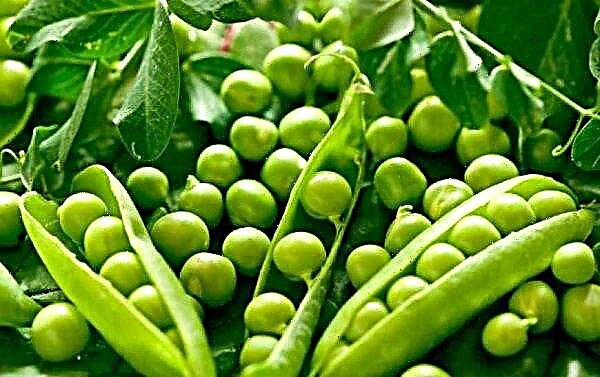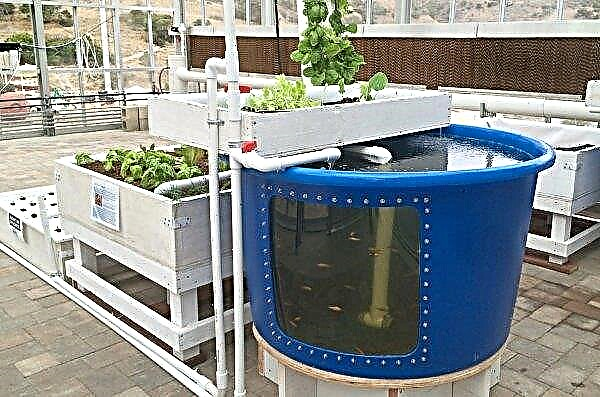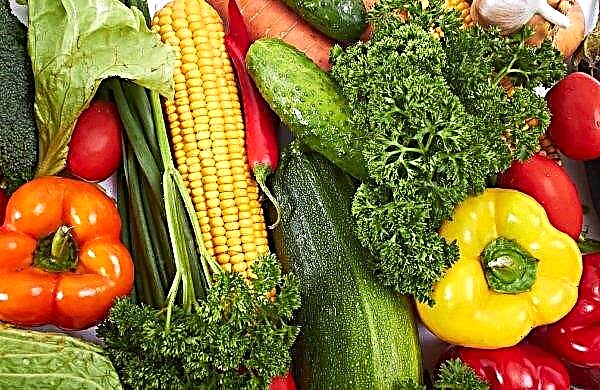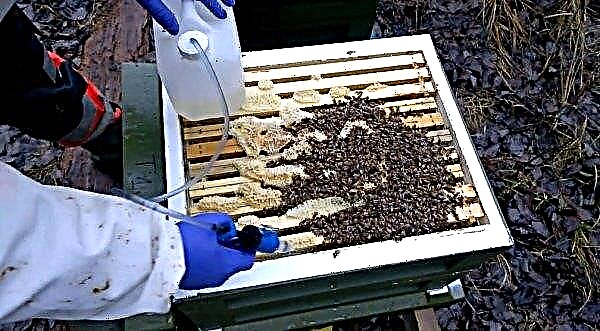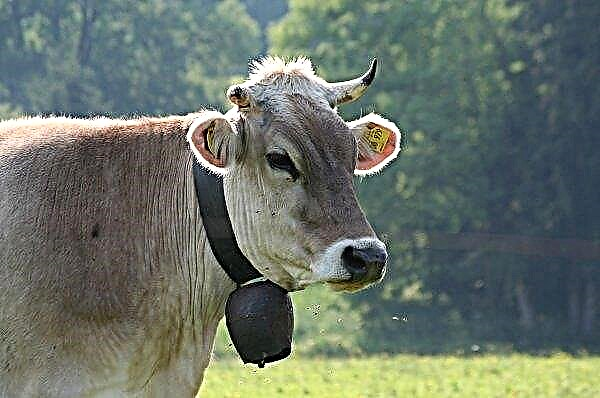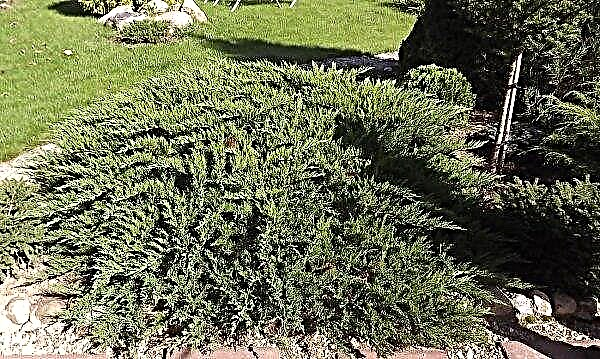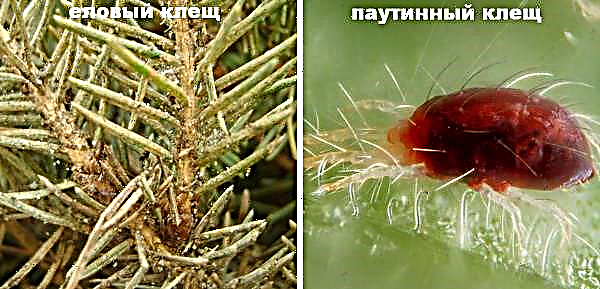In Russia and Ukraine, growing potatoes is traditional; this vegetable occupies one of the main places in cooking. Potatoes are grown both in small garden plots and in vast farming fields. This article will discuss the characteristics of the early Latona potato cultivar, various planting material planting techniques, and crop care methods.
Characterization and description of the variety
The Laton potato variety was created by Dutch breeders (HZPC HOLLAND B.V.), and in recent years has become very popular in the European part of the former Soviet Union (Ukraine, Russia, Moldova, Belarus). The variety is early ripe, very productive (up to 460 centners per 1 ha), 65-80 days pass from planting to ripening of tubers. For early consumption, Latona can be dug already a month and a half after planting, but, in this case, the potatoes will not be large.
Did you know? Potatoes are an excellent source of vitamin C, potassium, fiber, B vitamins, copper, tryptophan, manganese and even lutein. These substances contribute to the cessation of inflammatory processes in the human body, healthy blood circulation and increase immunity.
Suitable for cultivation in temperate regions. Potatoes usually form 4-8 vertical fleshy green stems above the soil surface; in the underground part, from 8 to 10 root crops form. The bush is lush, well leafy and sloppy. The splendor of the aerial part of Latona variety allows you to reduce the number of irrigation and cultivation, as it creates a shading of the root zone, which prevents the germination of weeds and evaporation of moisture from the soil.
Branched rhizomes (stolons) end in tubers rich in starch. The color of Latona's flesh is yellowish, and the skin is yellow-beige. The root system of this variety reaches 50 cm deep into the soil, the length of the side stolons is 15-20 cm. The tubers are round-oval, medium in size. The average weight of potatoes of this variety varies between 90-120 g, especially large specimens reach 140-150 g. The starch content in the tubers, depending on the soil, reaches 18%, which makes the potatoes friable and tasty during cooking. A ripened crop harvested in the second half of summer is well stored. Losses during long-term storage in well-equipped storage facilities make up only 10%.
The starch content in the tubers, depending on the soil, reaches 18%, which makes the potatoes friable and tasty during cooking. A ripened crop harvested in the second half of summer is well stored. Losses during long-term storage in well-equipped storage facilities make up only 10%.
Advantages and disadvantages of the variety
Potato varieties Latona has, according to vegetable growers, both positive and negative sides.
- Grade advantages:
- excellent taste;
- high overall yield;
- ability to long storage;
- the possibility of summer consumption in food;
- smooth root surface;
- starchy pulp;
- a large number of tubers under one plant;
- resistance to certain diseases of potato (late blight of tops and tubers, common scab).
- Cons of the variety:
- small size root vegetables;
- tendency to alternariosis.
Planting and growing potatoes
Planting potatoes is recommended in the spring. Planting dates may vary, depending on the region of cultivation, but by the time of planting, the soil should be warmed up to a depth of 15 cm and not yet lost spring moisture. Soil moisture, like soil fertilizer, is the key to a good future crop. In regions where there is too little rainfall during the summer, this crop is grown on artificial irrigation. For different climatic zones, different planting material landing techniques are recommended (in ridges, in trenches, or under a shovel). Observance of wide aisles during planting is necessary for the formation of a space sufficient for the plants to receive in a row of light and moisture.
In regions where there is too little rainfall during the summer, this crop is grown on artificial irrigation. For different climatic zones, different planting material landing techniques are recommended (in ridges, in trenches, or under a shovel). Observance of wide aisles during planting is necessary for the formation of a space sufficient for the plants to receive in a row of light and moisture.
Optimal landing times
The planting period is an important factor for this crop. If potatoes are planted in the optimal period, the plant responds to favorable conditions for development with an excellent crop (both in quantity and quality). In the southern regions (Crimea, Krasnodar Territory), tubers are planted around March 20, in regions with a temperate climate April 25 - May 1, in the northern regions (depending on weather) - at the end of May.
Did you know? Having an alkalizing and anti-inflammatory drug, potato soothes a stomach ulcer and duodenal ulcer, reduces the acidity of the stomach. The root crop, crushed into slurry, is able to relieve the inflammatory process associated with arthritis.
Crop rotation rules
Potato culture is not recommended to be grown in monoplantation, as the soil is infected with pathogens (viruses, bacteria, fungal spores) and solanaceous pests (wireworm, nematode). If possible, breaks in the cultivation of potatoes in a particular area should be at least three years.
- Good predecessors for potatoes would be:
- siderates (mustard, oats, peas, rape, phacelia);
- pumpkin crops.
Undesirable predecessors - vegetables belonging to the solanaceous family (eggplant, tomato, pepper).
After potatoes, beds can be used for growing:
- zucchini;
- cucumbers
- pumpkins;
- all varieties of cabbage and onions;
- squash;
- beans, peas, soy.
Soil requirements
Potatoes love light soils rich in nutrients. Soil must be fertilized with nitrogen fertilizers, with the addition of potash. Organic fertilizers can be added to the soil, for example, dung of domestic animals (cattle, chickens, rabbits, pigs). A bed fertilized and dug since autumn is only loosened before planting potatoes.
Important! In no case should you use sprouted planting material in the basement, since the sprouts on such potatoes are usually white (etiolated), thin and long. Being carried out into sunlight, such seedlings turn black and die.
Solanaceae culture needs a lot of light, so plants are planted in a place where they will be lit by the sun throughout the day. Gardeners have long noticed that in sunny areas, the potato harvest is twice as high as in partial shade. Potatoes prefer loose, slightly acidic soil mixed with sand. The soil pH for this crop should remain between 5.8-6.5.
Preparing planting material
Preparation of planting potatoes begin at least 2-3 weeks before planting in the soil. Tubers are brought into a warm, well-lit room. The temperature in the room where the potatoes sprout should not fall below + 15 ° C. A prerequisite is that the planting material should be stacked in boxes in no more than two layers. This contributes to uniform heating of tubers and the awakening of all eyes on the peel. If the planting potato is a little wilted, experiencing a lack of moisture during storage, its surface is moistened with a spray bottle. After sprouts 1.5-3 cm long appear on the tubers, the planting material is ready for use. Germination takes from 2 weeks to 1 month, depending on the temperature in the room. The higher the air temperature, the faster the germination. Before germination, planting material can be treated with an insecticide or growth promoter. You can combine these drugs.
After sprouts 1.5-3 cm long appear on the tubers, the planting material is ready for use. Germination takes from 2 weeks to 1 month, depending on the temperature in the room. The higher the air temperature, the faster the germination. Before germination, planting material can be treated with an insecticide or growth promoter. You can combine these drugs.
How to process planting potatoes:
- Growth stimulator "Poteytin". Stimulates the rapid awakening of eyes on root crops and the formation of thick, viable seedlings. The stimulator is produced by the manufacturer in ampoules, the contents of two ampoules will be enough to handle 100-120 kg of tubers. Growth stimulant is compatible with other plant protection products (treatants and insecticides).
- Among gardeners, a tuber treatment agent such as "Prestige". The drug protects both the aboveground and underground parts of the plant from insects (Colorado potato beetle, aphid, wireworm, bear) for 50-60 days.
- The drug "Maxim" prophylactically protects tubers from the development of fungal diseases (fusarium, phomosis, silver scab, rhizoctonia). During the treatment of tubers, you can mix both drugs ("Maxim" and "Prestige"). The vegetable grower will provide reliable protection for 100 kg of planting material by treating it in a mixture of 70 ml of Maxim and 100 ml of Prestige.
- Recently on sale appeared Kruiser drug used for double protection of planting potatoes. The active substance contained in the preparation protects the tubers from the attack of the Colorado potato beetle on young herbs and prevents the occurrence of root rot in the underground part of the plant. For 100 kg of small tubers, 70 ml of Kruiser is enough.
How to properly process the planting material:
- This procedure must be performed by two people, as one person will be uncomfortable.
- The tubers are laid out in a single layer on a wide polyethylene cloth and sprayed from a backpack garden sprayer with one (or a mixture) of protective preparations.
- Spraying is continued until a wet surface forms on the peel of the tubers.
- Next, two vegetable growers take on the opposite edges of the plastic sheet on which the potatoes lie, and gently shake it. Shaking is carried out until all potato sides are evenly moistened. This procedure must be carried out carefully so that delicate sprouts on tubers do not break off.

Landing methods
The recommended planting depth for potatoes is 8-10 cm (with soil coverage). Potatoes are planted as efficiently as possible in moist soil, the temperature of which is warmed up to +5 ... + 10 ° C at a depth of 15 cm. The optimal planting scheme for planting Latona tubers is 60-70 cm between rows, the intervals between tubers in a row from 25 to 30 cm.
Important! Large planting tubers, weighing more than 150 g, are cut into two parts on the day of planting. The optimal weight of planting potatoes is 60-100 g, such a mass of the mother tuber will provide the young plant with sufficient nutrients and moisture.
Trench
Potato trenching is recommended for sandy and light chernozem soils. Landing in trenches is not recommended for use on waterlogged soils, as potato tubers rot in damp. The depth of the landing trenches is 20-25 cm. After the potato field is plowed and its surface is leveled, using a manual plow or walk-behind tractor create longitudinal deep grooves for planting potatoes. Planting material is laid in the finished trenches and covered with soil on a level with the surface of the field.
After the potato field is plowed and its surface is leveled, using a manual plow or walk-behind tractor create longitudinal deep grooves for planting potatoes. Planting material is laid in the finished trenches and covered with soil on a level with the surface of the field.
Comb
This technique is suitable for soil with a close occurrence of water and a tendency to waterlogging, or it can be used on heavy, clay soils that form an airtight crust on the surface. The method differs from the traditional shovel landing in that before the commencement of work along the future potato rows, earthen longitudinal hills (ridges) are created. The height of the ridge varies from 15 to 20 cm, the row spacing remains traditional, 60-70 cm. Planting tubers are planted in the finished longitudinal ridges. Planting takes place without the use of a chopper or a shovel; the grower simply immerses the potatoes in a loose hill as deep as possible. This method is very convenient to use if there is a walk-behind tractor or cultivator in the household. In areas where high temperatures and droughts are often found in the summer, as well as on sandy soils, the method of planting potatoes in the ridges is not recommended, because earthen hills lose moisture very quickly.
Planting takes place without the use of a chopper or a shovel; the grower simply immerses the potatoes in a loose hill as deep as possible. This method is very convenient to use if there is a walk-behind tractor or cultivator in the household. In areas where high temperatures and droughts are often found in the summer, as well as on sandy soils, the method of planting potatoes in the ridges is not recommended, because earthen hills lose moisture very quickly.
Smooth
Smooth planting is the usual traditional planting of potatoes under a shovel, when one person digs out planting pits, placing their chain along or across the garden. The second gardener puts sprouted potatoes up in sprouts into the planting pits. Starting to dig planting holes for the next (parallel) row, a person with a shovel at the same time falls asleep planted tubers in the holes of the previous row. Landing under a shovel is recommended in small areas, with a southern location and loose, quickly warming up soil.
Features of care for the variety after planting
Care for potato plantings during the growing season consists of regular weed removal, top dressing, hilling, watering, and protection against diseases and pests.
Important! So that the rows of potatoes are even, the holes of the first row are dug according to the marking, along the cord. Smooth potato rows greatly facilitate further care of plantings (loosening, weeding, hilling).
Fertilizer
Fertilizer for potatoes is laid during the preparation of the field or beds, the optimal time for application is autumn. This is due to the fact that during the winter period, manure will begin to decompose. It is quite acceptable and the spring application of manure under the crop. At the same time, it is necessary to adhere to the recommended norms (2.5 tons per 10 hundred parts). The vegetable grower needs to remember that an excessive amount of fresh manure under the root crops causes their softening and decay. Potatoes are best grown on manure, as the crop produces high yields and forms tubers of good quality. Manure provides not only digestible nutrients for potatoes, but also enriches the soil. If not organic matter but mineral fertilizers are brought into the earth, then for every 10 acres you will need: 12.5 kg of nitrogen, 7.5 kg of phosphorus, 15 kg of potassium and about 3 kg of magnesium. Manure is not only a source of macro- and microelements, but also prevents the occurrence of alternariosis on plantings. This disease causes a large yield loss, sometimes reaching 50%.
Manure provides not only digestible nutrients for potatoes, but also enriches the soil. If not organic matter but mineral fertilizers are brought into the earth, then for every 10 acres you will need: 12.5 kg of nitrogen, 7.5 kg of phosphorus, 15 kg of potassium and about 3 kg of magnesium. Manure is not only a source of macro- and microelements, but also prevents the occurrence of alternariosis on plantings. This disease causes a large yield loss, sometimes reaching 50%.
Did you know? The healing antioxidants and anthocyanins contained in potatoes are very beneficial for the human heart. Root crops also contain healthy heart: fiber, potassium and vitamins C and B6.
Watering
If potatoes are planted, as expected, in humid spring soil, and it rains periodically during the summer, in a temperate climate you can not water the crop. In the southern regions, potato fields are watered twice: for the first time during the flowering of bushes, the second - two weeks after the first, at the time when root crops are tied.
Watering methods:
- Water is supplied to the root zone of plants by irrigation irrigation, for which they make longitudinal irrigation channels (irrigation ditches) between each pair of potato rows.
- Landings are watered by drip irrigation. It is good in that a certain amount of moisture can be supplied to each plant, if necessary, combining watering with fertilizing or applying insecticides to the soil (against wireworms, nematodes). For this type of irrigation, drip irrigation tapes equipped with special adjustable systems are laid out along rows of plants. The drip irrigation tape allows you to feed water at the same speed in any part of the field (uphill, on a slope).
- In the southern regions, you can use the sprinkling method on potatoes, as the high temperature allows the plants to dry quickly from wet drops. The sprinkling method can in no case be used in the northern regions, since excess moisture on the leaves of the potato provokes the occurrence of fungal and bacterial diseases.
Weeding and hilling
Over the entire growing season, weeding is carried out three times in culture. During weeding, the space between the rows and the root zone of the plants are freed from weeds. The third weeding is combined with hilling. After this, the bushes grow, close in the aisles and the need for weeding disappears, it even becomes harmful, since the blade of the weeding tool can damage the underground stolons. Weeding and hilling is carried out using a traditional chopper or Fokine plane cutter. To care for potatoes, medium and large format plane cutters are chosen.The optimal height of the earthen hill during earthing up is 30-35 cm. Earthing up contributes to the formation of additional stolons and shelters the root crops, which are underground, from the scorching sun.
Weeding and hilling is carried out using a traditional chopper or Fokine plane cutter. To care for potatoes, medium and large format plane cutters are chosen.The optimal height of the earthen hill during earthing up is 30-35 cm. Earthing up contributes to the formation of additional stolons and shelters the root crops, which are underground, from the scorching sun.
Pest and Disease Control
Common Potato Diseases:
- Late blight (Phytophtora infestans) - is the most common and dangerous disease of solanaceous crops. It has a significant impact on the crop, especially in rainy years, losses can reach 50% or more. The first symptoms of the disease appear on the leaves, in the form of large, round, greenish-yellow or gray spots, covered with fine fluff on the underside of the leaf plate. Brown, elongated spots appear on the stems and petioles. On the pulp of tubers, infection is observed in the form of brown streaks that start from the periphery and advance towards the center in the form of rays. This disease can be treated with Acrobat MZ 69 WG, or another dimitorphic fungicide. Fungicides stop the formation of the cell wall of the fungus. The drug is effective at all stages of the development of the disease. Leaf treatment of plants with fungicides has good prophylactic and therapeutic activity with a long lasting effect. On potato beds, the use of fungicides is recommended throughout the growing season, starting with the appearance of the first leaf on the plant. Depending on the severity of the disease and the degree of damage, it is recommended that from 1 to 5 treatments per summer with an interval of 7-14 days. You need to start treatment with the manifestation of the first symptoms of the disease in order to stop the infection before I spread throughout the potato field.
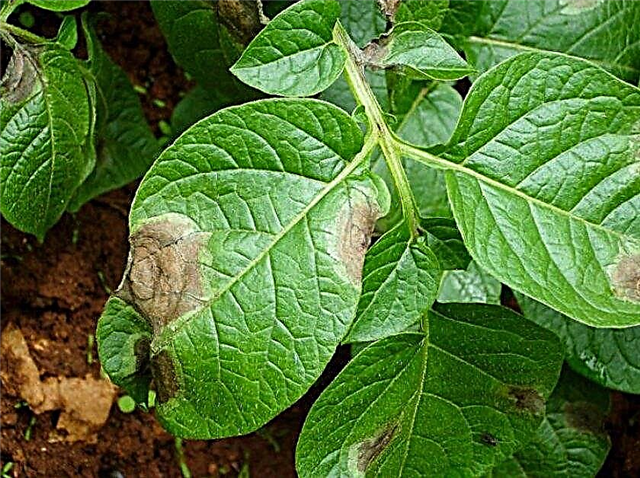
- Alternaria (Alternaria solani) - The disease is often found on planting potatoes. First of all, the symptoms appear on the leaves in the form of brown-gray spots with concentric zones. A velvety dark brown powder forms on the surface of the spots. In years with favorable conditions, tubers are also infected, on which spherical, brown, small spots appear. To combat alternariosis, it is recommended to use the contact fungicide "Polyram DF" containing 80% metiram, or other drugs with a similar effect.
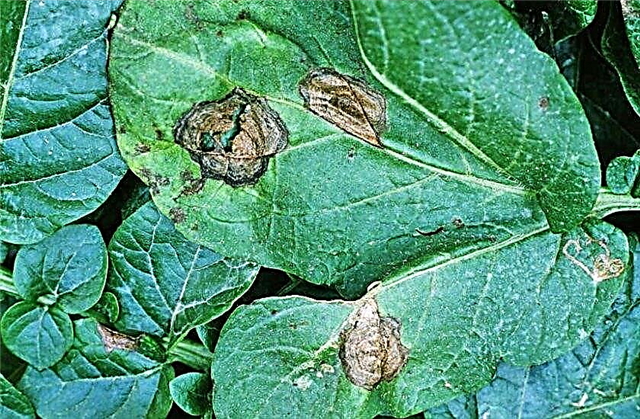
The most dangerous pest for potatoes is Colorado beetle. The insect produces 1-2 generations a year, hibernates in soil at a depth of 20-50 cm. In spring, after a short feeding, adult beetles lay their eggs on the back of the leaves. The larval stage of the Colorado potato beetle usually lasts 15-30 days, depending on the air temperature (the hotter the incubation faster). Adult beetles and larvae eat leaves and stems of potato bushes. In the absence of protective measures and a large number of bugs, crops can be compromised from the earliest stages of development.
Did you know? Potatoes are rich in chlorogenic acid and anthocyanins, chemicals that help lower blood pressure in hypertensive patients.
You can deal with Colorado beetles with such drugs:
- Fastak - an insecticide for the synthesis of pyrethroids, contains 50 g / l alpha-cypermethrin to combat adult beetles, larvae or eggs. It acts upon contact and ingestion, and also remains on the surface of leaves for a long time. The product is resistant to precipitation, provided that it was applied to dry plants several hours before it started to rain. It is recommended for prophylaxis when larvae or adult beetles appear. It is very important that the substance is applied evenly, covering the entire plant. The maximum number of treatments is 2 applications over a period of 7 to 10 days.
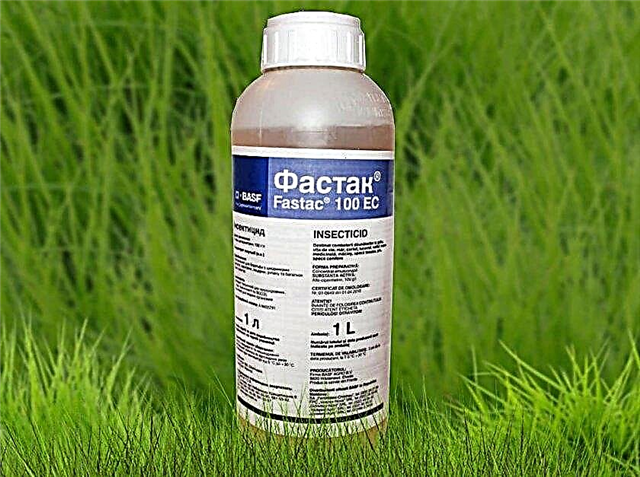
- "Alverde" - an insecticide that is highly effective against larvae and adults of the Colorado potato beetle. The drug contains 240 g / l metaflumizone. It acts on the nervous system of insects, blocking the sodium channel in the nervous system when ingested. To control the Colorado potato beetle, it is used after hatching larvae, although Alverde fights all the mobile stages of the pest, including adult beetles. The drug is used 1 to 2 times during the growing season of potatoes.
Did you know? Potato pulp is rich in tryptophan, amino acids and has natural sedative properties that help calm the nervous system.
Other pests of potato culture are: wireworm larva, nematodes, aphids. Preplanting treatment of tubers with dressers, such as Prestige, is used against wireworm larvae and nematodes. Aphids and other small pests on the surface of the bush are destroyed simultaneously with the Colorado potato beetle by any insecticide. The drugs are applied to the leaves with the help of knapsack pump sprayers that produce fine water dust.
Harvesting and storage rules
Laton potatoes are mainly grown for early consumption, so they dig it early when the tubers reach a weight of more than 30 g, and the peel is still peeled. They dig up potatoes for summer consumption in accordance with the demand or demand in the market. In the first half of summer, tubers do not yet reach their maximum size. Root crops for food in the fall and winter are harvested in adulthood, when the bushes become yellow and dry. They dig potatoes in dry and sunny weather in the absence of rainfall. Ware potatoes are lowered into the storehouse after prolonged listening, for at least 10-12 days. For drying, food root vegetables are laid out in partial shade, and only in the last two or three days the vegetables are moved to the sun, so that the skin coarsens under the influence of ultraviolet radiation. Tubers intended for planting next year are dried exclusively in the sun.
They dig potatoes in dry and sunny weather in the absence of rainfall. Ware potatoes are lowered into the storehouse after prolonged listening, for at least 10-12 days. For drying, food root vegetables are laid out in partial shade, and only in the last two or three days the vegetables are moved to the sun, so that the skin coarsens under the influence of ultraviolet radiation. Tubers intended for planting next year are dried exclusively in the sun.
Being in the sun causes an increase in corned beef in the tubers, which gives the potato peel a green color and a bitter taste. Bitterness protects planting material from mouse teeth. Latona is perfectly stored in dry, non-condensing, equipped with a ventilation system, storage facilities. Unlike other potato varieties, the loss of root crops of this variety during storage rarely reaches 10%.
Almost all climatic zones of our country, except the Far North, are suitable for growing early potatoes of the Latona variety. To get a good crop, it is enough to plant healthy planting material in a timely manner and provide planting with care and protection from pests and diseases.





